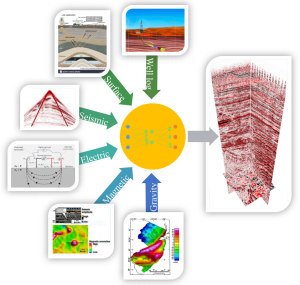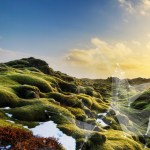Artificial intelligence and machine learning have developed at an incredible pace in the recent years. With that development came new algorithms, workflows, paradigm shifts, failures, open software, open data, tutorials and courses at a rate too fast for anyone to follow. For geoscientists getting started with AI the first steps can be intimidating, and those who wish to stay up to date often do not have the time to do so. As a group of EAGE members and volunteers we aim to help find the bits relevant for geoscientists. In the last year we have shared short summaries on a diverse range of topics in the EAGE Digital Newsletter. That was well received and after feedback at the EAGE 2021 Annual conference we now increase the effort to a periodic newsletter that focuses on AI and ML for geoscience and keeps an eye out for significant stories emerging outside. We also do not want to overload you with information. The newsletter format will therefore be short and to-the-point with links to relevant information and a short synopsis and opinion from our side. You are also welcomed to join the EAGE Artificial Intelligence group on LinkedIn.
![]()
![]() What: AI For Everyone, a 6-hour online lecture series on Artificial Intelligence and machine learning.
What: AI For Everyone, a 6-hour online lecture series on Artificial Intelligence and machine learning.
![]() Why this is useful: The field of AI can get too technical or magical really quickly. This non-technical course by DeepLearning.AI (an AI focused technology education company) is not focused on coders and will “help you understand AI technologies and spot opportunities to apply AI to problems in your own organization”. Even if you will never build or train a deep neural network, chances are high that you will work with one sooner or later. Also, for experts, the course may be a good example of how to explain the topic to the non-initiated (or the course you ask your boss to take).
Why this is useful: The field of AI can get too technical or magical really quickly. This non-technical course by DeepLearning.AI (an AI focused technology education company) is not focused on coders and will “help you understand AI technologies and spot opportunities to apply AI to problems in your own organization”. Even if you will never build or train a deep neural network, chances are high that you will work with one sooner or later. Also, for experts, the course may be a good example of how to explain the topic to the non-initiated (or the course you ask your boss to take).
![]()
![]() What: “Deep Learning for Geophysics: Current and Future Trends”. Siwei Yu and Jianwei Ma from the Harbin Institute of Technology in China have written an excellent paper in which the authors “address the basic concepts, state-of-the-art literature, and future trends by reviewing DL approaches in various geosciences scenarios.” . They analyze recent trends of deep learning in geophysics and offer promising directions for future research. Additionally, they offer a small coding tutorial.
What: “Deep Learning for Geophysics: Current and Future Trends”. Siwei Yu and Jianwei Ma from the Harbin Institute of Technology in China have written an excellent paper in which the authors “address the basic concepts, state-of-the-art literature, and future trends by reviewing DL approaches in various geosciences scenarios.” . They analyze recent trends of deep learning in geophysics and offer promising directions for future research. Additionally, they offer a small coding tutorial.
![]() Why this is useful: Since deep learning is still somewhat new there are not that many tutorials and overview papers. This paper is a gem for both novice and experts.
Why this is useful: Since deep learning is still somewhat new there are not that many tutorials and overview papers. This paper is a gem for both novice and experts.

Yu, S., & Ma, J. (2021). Deep learning for geophysics: Current and future trends. Reviews of Geophysics, 59, e2021RG000742.
![]()
![]() What: TorchGeo, a Python package that allows users to use heterogeneous geospatial data in PyTorch-based deep learning pipelines.
What: TorchGeo, a Python package that allows users to use heterogeneous geospatial data in PyTorch-based deep learning pipelines.
![]() Why this is useful: The bulk of the AI literature deals with RGB and greyscale photos or video data. When working with various geospatial data consisting of different numbers of spectral frequency bands and/or sampled in different coordinate systems, it is not always straightforward how to use the open source toolboxes from the image processing community. Researchers from University of Illinois and Microsoft have teamed up to address this and other issues which has resulted in the release of TorchGeo. They also offer pre-trained models for many common remotely sensed imagery sources. To top it off, there are also dataloaders for common geospatial datasets from the literature.
Why this is useful: The bulk of the AI literature deals with RGB and greyscale photos or video data. When working with various geospatial data consisting of different numbers of spectral frequency bands and/or sampled in different coordinate systems, it is not always straightforward how to use the open source toolboxes from the image processing community. Researchers from University of Illinois and Microsoft have teamed up to address this and other issues which has resulted in the release of TorchGeo. They also offer pre-trained models for many common remotely sensed imagery sources. To top it off, there are also dataloaders for common geospatial datasets from the literature.
![]()
![]() What: The Planetary computer Data Catalog includes petabytes of environmental monitoring data, in consistent, analysis-ready formats. The majority of the data are satellite, land cover and weather measurements but there are also several digital elevation models.
What: The Planetary computer Data Catalog includes petabytes of environmental monitoring data, in consistent, analysis-ready formats. The majority of the data are satellite, land cover and weather measurements but there are also several digital elevation models.
![]() Why this is useful: Packages like TorchGeo are useless without data, which is what this site offers. The “Planetary Computer” is an evolution of Microsoft’s AI for Earth program, which was launched in 2017, and one of the companies initiatives in sustainability. The focus is on preserving and protecting the biodiversity and health of the world’s ecosystems. Microsoft aims to put data and digital technology to work (on its Azure platform) through an ambitious program to aggregate environmental data from around the world. A concrete example is the monitoring of land forest or ice cover. There are plenty of Jupyter notebook examples.
Why this is useful: Packages like TorchGeo are useless without data, which is what this site offers. The “Planetary Computer” is an evolution of Microsoft’s AI for Earth program, which was launched in 2017, and one of the companies initiatives in sustainability. The focus is on preserving and protecting the biodiversity and health of the world’s ecosystems. Microsoft aims to put data and digital technology to work (on its Azure platform) through an ambitious program to aggregate environmental data from around the world. A concrete example is the monitoring of land forest or ice cover. There are plenty of Jupyter notebook examples.
![]()
Discover EAGE Learning Resources on A.I. and machine learning






